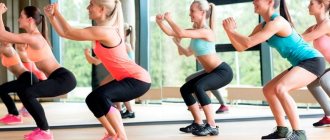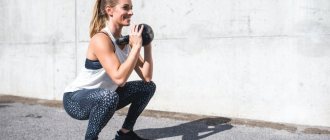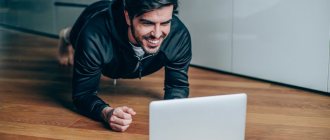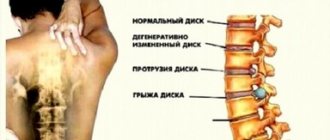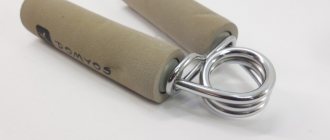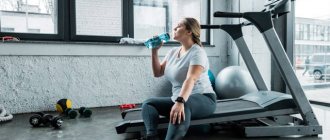The benefits of squats are very great, as evidenced by the fact that the exercise is present in the training programs of absolutely all sports. It allows you to use almost all the muscles of the lower body. There are a lot of different squat techniques; the exercise can also be done with your own weight or with weights.
People practice squats for various purposes, not just for body shaping.
- Someone really wants to lose weight, while others, on the contrary, squat with weights to gain muscle mass.
- Some are trying to improve endurance, others muscle strength;
- For others, the goal is to improve the condition of the joints, tendons, and spine;
- Professional athletes squat to improve their skills and warm up during training;
- As part of exercise therapy, squats allow you to work out problem areas of the body.
Next, we will take a closer look at the benefits of squats, specifically for women - what are the advantages of this exercise?
What are the benefits of squats for men?
Squats are a classic basic exercise for training the muscles of the lower body. With their help, you can effectively pump blood from the feet to the heart and brain, normalize blood pressure, strengthen the vascular system, eliminate and prevent stagnation in the pelvis. Below we will take a closer look at what squats do for a man.
Improve potency
The main advantage of squats for men is stimulation of blood flow in the genitals and strengthening of the pelvic muscles. During the exercise, there is a powerful flow of blood to the testicles, as a result of which their nutrition improves and the production of testosterone and sperm is activated. Intense blood flow causes blood vessels to dilate, including those of the penis. If you do squats regularly, your erection will become fuller and more confident.
Find out about the 8 best ways to improve erection quality.
Video about the benefits of squats
Helps avoid stagnant processes
The main advantage of squats for men leading a passive lifestyle is improved blood flow in the pelvic area. Stagnation of blood, or pelvic venous congestion, often causes congestive prostatitis, chronic pain of unknown origin. Regularly doing squats will help normalize blood circulation and the functioning of the venous valve mechanism.
Exercises will increase the tone of the pelvic muscles and rectum. This is important for men after 60 years of age. Some people at this age have weakened sphincters, urine leakage, and hemorrhoids. In addition, increased blood circulation will help eliminate swelling of the prostate due to adenoma and prostatitis.
Increase muscle mass
Squats create favorable conditions for the development of muscle mass throughout the body. This is a multi-joint exercise that uses several muscle groups at once:
- Quadriceps.
- Large glutes.
- Soleus.
- Biceps femoris.
- Calf.
- Adductor muscles of the thigh.
- Back extensors.
- Abdominal Press.
Muscles worked during squats
Improve joint function
Provided the correct technique is followed, squats help improve the nutrition of the cartilage tissue of the joints, stimulate the production of lubricating fluid, and strengthen the supporting ligaments. A sedentary lifestyle provokes crunching in the knees, periodic aching pain, and increased trauma. Squats eliminate these phenomena and prevent the development of arthrosis and arthritis.
Strengthens the cardiovascular system, normalizes blood pressure
Not only the heart, but also other muscles are involved in the process of pumping blood. The larger they are, the greater the volume of blood flow passing through them. The famous kinesiologist S. Bubnovsky in his book “Healthy Vessels, or Why Does a Person Need Muscles?” calls squats part of the “health triad” along with push-ups and pumping the abs.
Squats promote the development of the circulatory network. The vessels grow through the muscles (vascularization occurs) and take on part of the load of the myocardium. During exercise, the number of working capillaries increases by 2 times. Squats are especially useful for men after 60 years of age, since from this age muscle capillarization decreases by 20%.
Microscope photo: fibers on a muscle section surrounded by capillaries
Squats give a powerful boost to the blood. The increased flow massages the walls of blood vessels and improves their elasticity. As a result of regular exercise, the average speed of blood flow increases due to a decrease in vascular resistance, and diastolic pressure is normalized.
Speed up metabolism
During squats, large muscles work, requiring increased energy consumption. Trained muscle tissue burns calories even at rest. With regular exercise, the body adapts and increases the speed of biochemical reactions. It should be noted that appetite also increases at the same time. To lose weight, you need to be in a calorie deficit.
Increase flexibility and improve coordination
When performing a squat, the body learns to maintain balance and uses stabilizer muscles. The lower back is actively working. Squats help increase the elasticity of the hamstrings, Achilles tendons, and stretch the back and inner thighs.
Effect
If you squat regularly, you can get undeniable benefits for organs and tissues. This is due to the fact that during training a large number of muscles are involved, which begin to actively work. At the initial stages, preference should be given to the classic squat technique. And only after carefully working it out can you move on to more complicated gymnastics.
Here are the main positive effects:
- Toned and firm buttocks.
A beautiful thigh area is admired by both men and women. To give this part a toned and attractive look, you should include squats in your daily training program. After a month of training, you can observe an excellent result - an attractive appearance of the forms is ensured.
- Strengthening tendons, joints and ankles.
During squats, the lower part of the body actively works. In this regard, the active work of the limbs is noted, which has a positive effect on the development of muscles, joints and tendons.
In order not to overshadow the positive effect with unpleasant consequences in the form of dislocations, sprains and other problems, it is important to monitor the even distribution of the load on the body. You should not overload the body, trying to achieve optimal results in a short time. In squats, as in other types of gymnastics, it is important to maintain consistency and uniformity.
Possible harm and contraindications
Direct contraindications to performing squats:
- Coxarthrosis of the hip joints.
- Gonarthrosis of the knees (cartilage deformation).
- Severe cardiovascular pathologies.
- Injuries of the musculoskeletal system.
- Obesity. Even bodyweight squats will put a lot of stress on your knees.
If you have varicose veins, you should consult your doctor before starting exercise.
If the exercise is performed incorrectly, inflammation of the knee joints will develop, ligament damage and spinal injuries may occur.
Is it possible to do squats with hemorrhoids: yes, but not in the acute stage (bleeding) and without heavy weights. Doctor's opinion from the site https://proctolog81.ru/forum/viewtopic.php?id=2921:
Advice if a knot has formed due to overload:
How many squats should you do?
For beginners, it is enough to do 30 repetitions every day: 10 in the morning, afternoon and evening. As your muscles strengthen, you can perform 50 squats daily for preventive purposes. Trained men increase the number of squats to 300-400. To obtain visible results, intensive training will be required at least 3-4 days a week. Dr. Bubnovsky suggests that office workers do 30 squats every hour of sedentary work.
For men over 40 years of age, squats are necessary to maintain normal tone of the pelvic organs and prevent prostatitis. If there are no back problems, then you can squat with weights. At this age, it is important to create conditions for the muscles to fully recover: sleep at least 8 hours, increase the amount of protein in the diet, take a break from the gym 3 days a week.
At 50 years old, you need to start with 10 squats a day and monitor the sensations, gradually adding 3-5 repetitions. It is advisable to start squats with weights only after an X-ray of your knees and consultation with a doctor.
With a barbell
This version of the exercise is classified as “based on the location of the center of gravity.” It is used more often than usual by weightlifters. It is not recommended to perform this element without prior preparation, as there is a high risk of injury.
To perform barbell squats, you must do the following:
- It is important to take the starting position with your feet shoulder-width apart with your toes turned slightly inward.
- After this, you need to take the barbell and place it on your forearms.
- Now you should perform squats, trying to maintain balance without shifting the center of gravity.
This type of gymnastics is suitable for experienced athletes who have worked their muscles and are ready for increased loads.
How to squat correctly - execution technique
A prerequisite is a warm-up for 5 minutes: rotation of the knees, feet, pelvis, bending with a straight back, stretching the calf muscles, Achilles tendons, and the front of the thigh.
Warm-up option before squats
Bodyweight squats
Basic rules for safe squats without additional weight:
- The pelvis is laid back and does not fall below the knee.
- The knee does not go beyond the toe.
- The back is straight.
- Support on the center of the foot or heel.
- Look ahead.
- The toe and knee are pointing in the same direction.
- Hands behind your head or in front of you.
If you have a sore lower back, only squats without weight or with a light bar are available. A support belt will help with barbell training in the gym, but for many it prevents them from breathing properly. It’s better to develop your own muscle corset. At home, you can squat with your own weight or a kettlebell. In the first case, aerobic exercise predominates, in the second - strength exercise. As your muscles and ligaments strengthen, you can do deep squats and slightly extend your knee beyond your toes.
How to breathe: when lowering, inhale; when extending your legs, exhale through your mouth.
Video about the classic squat technique: benefits and common mistakes
Plie, sumo
For men, these types of squats are most beneficial. During their implementation, the inner surface of the thigh actively works and stretches, and the blood supply to the genital organs increases. It is important not to roll your knees and feet inward and keep your back straight.
In sumo squats, the pelvis is pulled back more strongly, the back is slightly tilted forward, and the load falls on the back of the thigh. This position allows you to lift heavy weights.
How to do plie squats with dumbbells in your hands
With weights
For more intensive muscle training, you can pick up a barbell plate, a kettlebell, or squat with a barbell on your shoulders. The pancake or weight should be held in front of you or lowered down. The main thing is that your shoulders are straightened and your back is not hunched.
With a weight
With a barbell
If you hold the barbell in front of you (front squats), the load will move to the front of your thigh. A pad under the heels will help make it easier to follow the technique.
In the Smith machine
The Smith machine allows you to work out the muscles of the lower body as efficiently and safely as possible. There is no need for a belay partner; the bar moves exactly along one trajectory.
Technique for performing squats in a Smith machine
Common mistakes
Incorrect load distribution
With poorly developed gluteus maximus muscles and hamstrings, the center of gravity involuntarily shifts to the toes. This places excessive stress on the spine, knees and minimizes benefit.
Knees going beyond toes
When deep squats are below parallel to the floor and the buttocks touch the calves, the joints bend at an acute angle and look beyond the line of the fingers. This leads to thinning and deformation of cartilage and injuries. When mastering biomechanics, they train while facing a wall.
Subscribe to our Yandex Zen channel!
Reduction of legs
Insufficiently developed ligaments lead to involuntary connection of the knees when lowering the body. Training your legs with a rubber band will help with this.
Tailbone twisting
This happens when there is a lack of flexibility in the hip joints. To tone them up, stand with your feet wide apart, rest your palms on the cups, spread them out to the sides as much as possible and perform a series of springy movements.
Best programs
Beginner's 15 Week Bodyweight Squat Program at Home
Bodyweight squat program for trained men
Example of a strength program:
- First 3 weeks. Choose the most comfortable weight. Train 2 times a week. Perform 20 approaches. Add 2 kg at each workout.
- Second 6 weeks. There should be only 8 workouts. On each of them you need to add 1 kg to the weight.
- Training once every 5-7 days. Add 0.5-1 kg on each until the weight reaches the maximum possible. This will end the cycle.
Not all men can squat productively due to too long femurs or structural features of the joints. As an alternative, deadlifts and leg presses are suitable. For the latter, a properly designed simulator that does not overload the tendons - "Hammer" or "Nautilus" - is important.
For men over 50 with joint diseases
With the help of properly performed squats, you can improve the condition of your joints and get rid of chronic pain. You can start exercising only after consulting a doctor.
Option 1
Legs together, feet parallel, grab support with your hands (for example, door handles) without leaning back. Sit down 20-30 times.
Such squats are suitable for men after 50-60 years of age with chronic diseases of the knees and prostate. When performed regularly, they will help improve joint mobility and the condition of the genitourinary system.
Option 2 – horseman pose (mabu) from qigong
Place your feet parallel to each other at a distance of 1 m, slowly squat down, trying to make your thighs parallel to the floor. Do not push your knees inward. Your arms can be extended forward. You need to learn to hold the pose for 1-3 minutes.
Kinds
In addition to the classic method, there are other variations of this gymnastics. Experienced fitness trainers divide this training method into the following types:
- by location of the center of gravity;
- by depth;
- position of the feet;
- manner of execution - statically or dynamically.
Which squat option you prefer depends on personal motivation, physical fitness and preference.
Real reviews from men
They write on the forums that deep squats are most effective for strengthening potency. From the forum https://antiwomen.ru/viewtopic.php?t=56691&start=25:
About testosterone production from the site https://forum.pickup.ru/topic/64548-squat/:
